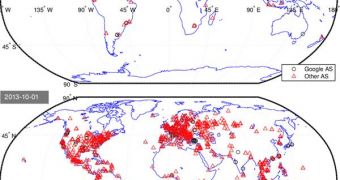Google is a big fan of its data centers. It's very proud of what it has achieved, and the company uses Google software and hardware almost exclusively. But, sometimes, having huge, state-of-the-art data centers isn't the best solution.
Sometimes, a quick and dirty approach actually provides better results. That's what a new report by the University of Southern California seems to suggest. Researchers have been using new tools they developed to pinpoint the location of a server.
Incidentally, they started using the new tools just as Google decided to greatly expand its content network. In the past year or so, the Mountain-View giant has started serving search results from seven times more locations.
In October 2012, Google was providing search results via less than 200 locations at a little over 100 ISPs. By July this year, the numbers had grown to over 1,400 locations and 850 ISPs.
The search giant, like several other large internet companies, has servers placed at several ISPs, which act as the first response to a request. These servers, which are owned by Google but placed at locations belonging to the ISPs, cache the most popular content, on YouTube for example.
This way, users get to the videos they want to see faster, since they're on the network of their local provider. ISPs use up less external bandwidth and Google speeds up its sites. Everyone wins in this scenario.
Now, it seems, Google has started using the very same servers to provide search results as well. The company is also adding new hardware at more locations, apparently.
When a user searches for something, the query is directed to the local server which then sends it to a Google data center, to speed things up. That may seem counterintuitive, but using these servers as middlemen is actually faster than a direct connection.
The servers maintain a constant, always-on connection to the data servers, which means data arrives faster than if it were channeled via the regular internet connections.

 14 DAY TRIAL //
14 DAY TRIAL //